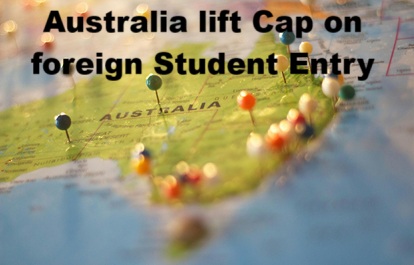Australia Lifts Foreign Student Cap to 295,000
Australia has long been one of the most attractive destinations for international students, boasting world-class universities, vibrant cities, and multicultural communities. In a significant policy shift announced recently, the Australian Government has raised the foreign student cap by 9%, allowing up to 295,000 international students to enroll in Australian educational institutions next year. This move marks not only a response to the evolving demands of global education but also an economic strategy that intertwines migration policy, housing affordability, and Australia’s “soft power.”
Why Did Australia Lift the Cap?
To understand this policy change, it’s essential to look back. In recent years, Australia had imposed strict limits on international student numbers. The primary reason was to control record migration levels, which had contributed to an unprecedented surge in housing prices and strained public services. By capping student visas, the government aimed to balance the economic benefits of international education with the practical realities of urban congestion and housing shortages.
However, as Australia emerged from the Covid-19 pandemic, a renewed urgency arose to re-engage with the global education market. The 2023 financial year saw international students returning in record numbers. Australia granted nearly 600,000 student visas, the largest cohorts coming from China and India. This surge underscored how critical foreign students are to the national economy and the viability of universities.
In response to these pressures and opportunities, the Australian government announced that an additional 25,000 places would be created in 2026, bringing the total cap to 295,000. The policy aims to:
- Boost the international education sector.
- Support universities and vocational institutions.
- Address workforce shortages in specific skills areas.
- Strengthen relationships with neighboring Southeast Asian countries.
- Help stabilize and eventually lower housing demand pressures by adopting new regulations.
This policy is not merely about numbers. It’s about reimagining how Australia hosts and supports international students in a post-pandemic world.

The Prioritization of Southeast Asian Students
One of the most notable aspects of this policy is Australia’s commitment to prioritizing Southeast Asian applicants. According to the announcement, larger public universities will need to demonstrate that they can provide safe and secure housing to access their share of increased student allocations. This requirement reflects growing concern that international student housing, if left unregulated, drives rental prices beyond what average Australians can afford.
But why focus on Southeast Asia?
There are several reasons:
- Economic Diversification: Australia has traditionally relied heavily on Chinese students, who make up a significant portion of international enrollments. With geopolitical tensions rising and an overdependence on China posing economic risks, Australia is eager to cultivate more balanced relationships with Southeast Asia.
- Soft Power Diplomacy: As Julian Hill, the Assistant Minister for Education, explained, bringing students from neighboring countries fosters goodwill, cultural exchange, and long-term diplomatic ties. International students often stay connected to Australia, becoming ambassadors for Australian values, trade, and tourism.
- Regional Stability and Cooperation: Engaging more deeply with Southeast Asia aligns with Australia’s broader foreign policy objectives, including regional security cooperation and sustainable development.
Measures to Control ‘Out of Control’ Migration
The decision to expand the cap did not come without safeguards. Authorities have learned lessons from past surges in international student numbers, which sometimes fueled unscrupulous practices and visa loopholes. In response, the Australian government is implementing several control measures:
- Higher Visa Fees: The cost of a student visa will be doubled, sending a clear signal that Australia wants serious students, not individuals merely seeking a backdoor into longer-term residency.
- Stricter Rules on Extensions: Loopholes that allowed students to indefinitely extend their stay through serial enrollments will be closed.
- Quality Assurance: Universities and vocational institutions will be required to show that their educational offerings align with Australia’s workforce needs, ensuring students acquire valuable, employment-ready skills.
These measures, according to the government, have already begun to bear fruit, with Julian Hill noting that student numbers were “growing out of control,” but new policies were restoring order.
Impact on Housing and Local Communities
One of the most pressing challenges related to international education is the impact on housing markets. With record migration came skyrocketing rents and housing shortages in major cities such as Sydney and Melbourne. Critics argued that the influx of students was unsustainable and unfairly burdened local communities.
To address this, the government has linked the expansion of student places to housing obligations. Institutions must prove they can offer safe, affordable accommodation before receiving additional student allocations. This approach aims to:
- Prevent further spikes in rental prices.
- Ensure students are not exploited in overcrowded living situations.
- Support healthier urban planning and community integration.
It’s a delicate balancing act: welcoming the economic contributions of international students while protecting the quality of life for Australians.
Economic and Educational Benefits
Despite these challenges, the rationale for increasing the cap is compelling. The international education sector is Australia’s fourth-largest export industry, contributing tens of billions of dollars annually. Beyond direct economic gains, international students:
- Help sustain regional and urban universities.
- Create thousands of jobs in education, hospitality, and retail.
- Enrich Australian classrooms with diverse perspectives.
- Build lifelong connections that benefit tourism and trade.
As Education Minister Jason Clare said, “This is about making sure international education grows in a way that supports students, universities, and the national interest.”
Universities themselves largely welcomed the changes, describing them as a “sensible increase” in places.

How the New Cap Will Be Allocated
According to the government’s plan, roughly two-thirds of the additional places will go to universities, while the remaining one-third will be allocated to the vocational skills training sector. This split reflects a growing recognition that Australia needs skilled workers in trades and services, not just degree-qualified graduates.
Visa Policy Changes: What Students Should Know
For prospective students, the policy brings both opportunities and higher expectations. Some of the key visa changes include:
- Higher Costs: Doubling the visa fee will increase the upfront financial burden on students and their families.
- Tighter Eligibility Criteria: Students must demonstrate genuine intention to study and satisfy stricter proof-of-funds requirements.
- Monitoring of Course Progress: Institutions will be expected to ensure students are genuinely engaging with their studies.
These adjustments are part of a broader effort to reinforce the integrity of Australia’s international education system.
The Role of Universities and the Message to the World
The success of this new approach depends on universities stepping up to provide:
- Quality education.
- Supportive communities.
- Safe, affordable accommodation.
Assistant Minister Julian Hill said: “It is important for Australia’s soft power that we bring the best and brightest from our Southeast Asian neighbors to have a bit of Australia with them for the rest of their life.”
This vision is about more than economics—it’s about cultural exchange and building bridges across borders.
Looking Forward: What Does This Mean for Students Globally?
For international students weighing their options, Australia’s expanded cap sends a powerful signal: Australia is open for education, but with clear standards.
Whether you’re from Vietnam, Indonesia, Malaysia, India, or beyond, this policy could be your gateway to:
- A world-class degree.
- Connections that span continents.
- Career pathways in one of the most prosperous economies.
However, students must be prepared to navigate higher visa fees, stricter criteria, and increased scrutiny of their study intentions.
Conclusion
Australia’s decision to lift the foreign student cap to 295,000 marks a pivotal moment in its education and migration policy. The plan promises to:
- Support universities and vocational institutions.
- Prioritize Southeast Asian engagement.
- Curb unsustainable migration practices.
- Address housing shortages.
- Reinforce Australia’s position as a global education powerhouse.
As international education redefines itself in the wake of Covid-19, Australia is staking its claim as a leader in welcoming students responsibly, sustainably, and strategically.
Disclaimer
The information provided in this blog, “Australia Lifts Foreign Student Cap by 9%,” is intended solely for general informational and educational purposes. While every effort has been made to ensure accuracy, readers should note that policies, visa requirements, and regulations related to international student admissions in Australia are subject to change without prior notice. This blog does not constitute professional, legal, immigration, or educational advice, nor should it be relied upon as a substitute for guidance from qualified experts or official government resources. Prospective students and their families are strongly encouraged to consult the Australian Department of Home Affairs, official university admissions offices, and licensed education agents for the most current and specific information relevant to their circumstances. The website www.merijobs.in and the author of this content do not accept liability for any loss, damage, or inconvenience caused as a result of reliance on this material. Use of this article is at the reader’s discretion and risk. By accessing this content, you agree to hold the author and www.merijobs.in harmless from any consequences arising from its use.


Recent Comments